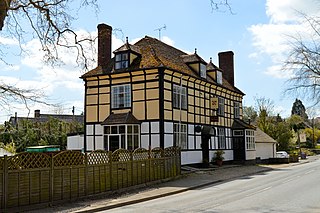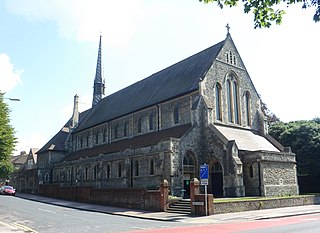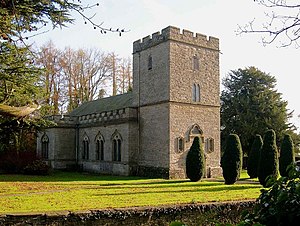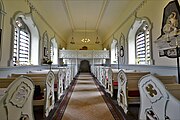History
The original church was probably constructed in the 14th century. [3] Arches from the interior of this building were removed in the 18th century to form an eye-catcher in the grounds of Shobdon Court, the Bateman family home. The Shobdon Arches, [3] as they are known, have subsequently "weathered disastrously." Between 1749 and 1752, John Bateman undertook a complete rebuilding in the Gothic Revival style. [3] The architect is unknown. Bateman's uncle was a friend of Horace Walpole and many members of their circle have been suggested as possible designers, including William Kent, Daniel Garrett, Stephen Wright, John Vardy, Richard Bentley, William Robinson and Henry Flitcroft. Jenkins himself favours Richard Bentley. The style is clearly influenced by the contemporary Strawberry Hill House and the works of Batty Langley.
The church remains an active parish church, part of the Arrowvale Group of churches. [4] The Parochial Church Council is supported by The Shobdon Church Preservation Trust, established to ensure; "The preservation and upkeep of St John the Evangelist Parish Church, Shobdon, a Grade 1 listed building, and the education of the public in the history and architecture of the church." [5]

Pembridge is a village and civil parish in the Arrow valley in Herefordshire, England. The village is on the A44 road about 6 miles (10 km) east of Kington and 7 miles (11 km) west of Leominster. The civil parish includes the hamlets of Bearwood, Lower Bearwood, Lower Broxwood, Marston, Moorcot and Weston. The 2011 Census recorded the parish population as 1,056.

Garway is a civil parish in south-west Herefordshire, England. The population of the civil parish was 430 at the 2011 census. It is set on a hillside above the River Monnow about 6 1/4 miles (10 km) northwest of Monmouth. It is a sparsely populated area, mainly agricultural in nature. There are several small centres of population including Garway itself, Broad Oak, The Turning and Garway Hill.

The Church of St Mary and St David is a Church of England parish church at Kilpeck in the English county of Herefordshire, about 5 miles from the border with Monmouthshire, Wales. Pevsner describes Kilpeck as "one of the most perfect Norman churches in England". Famous for its stone carvings, the church is a Grade I listed building.

St John the Baptist's Church is in the town of Knutsford, Cheshire, England. The church is recorded in the National Heritage List for England as a designated Grade II* listed building. It is an active Anglican parish church in the diocese of Chester, the archdeaconry of Macclesfield and the deanery of Knutsford. Its benefice is combined with that of St John the Evangelist, Toft.

Shobdon is a village and civil parish in Herefordshire, England, about 15 miles north of Hereford, six miles west of Leominster, and 2 miles southwest of the Mortimer's Cross. According to the 2001 census, the parish population was 769, consisting of 386 males and 383 females. The population had increased to 816 by the time of the 2011 census.

St John the Evangelist's Church is an Anglican church in the Preston Village area of Brighton, in the English city of Brighton and Hove. The Grade II listed building, designed by Sir Arthur Blomfield, was started in 1901 but did not take its present form for another quarter of a century. In the meantime, the nearby parish church of Preston was severely damaged by fire, and the new church was granted the parish church status which it still retains.

St Peter's Church is a former Anglican church in the Preston Village area of Brighton, in the English city of Brighton and Hove. The 13th-century building, standing on the site of two older churches, was restored in the late 19th century and again after a serious fire in 1906. It was the parish church of Preston until 1908, when the newly built St John the Evangelist's Church gained this status. The Diocese of Chichester declared St Peter's redundant in 1990, and it is now owned by the Churches Conservation Trust. It has Grade II* listed status, reflecting its architectural and historical importance.

John Bateman, 2nd Viscount Bateman was a British politician who sat in the House of Commons from 1746 to 1784.

St John the Evangelist's Church is the Anglican parish church of the Upper St Leonards area of St Leonards-on-Sea, a town and seaside resort which is part of the Borough of Hastings in East Sussex, England. The present building—a "very impressive and beautifully detailed" church in the Gothic Revival style, with a landmark tower—combines parts of Arthur Blomfield's 1881 church, wrecked during World War II, and Harry Stuart Goodhart-Rendel's 1950s rebuild. Two earlier churches on the site, the second possibly designed by Samuel Sanders Teulon, were themselves destroyed earlier in the 19th century. The rich internal fittings include a complete scheme of stained glass by Goodhart-Rendel's favoured designer Joseph Ledger and a 16th-century painting by Ortolano Ferrarese. English Heritage has listed the church at Grade II* for its architectural and historical importance.

St John the Evangelist's Church is in the village of Crawshawbooth, near Rawtenstall, Lancashire, England. It is a redundant Anglican parish church formerly in the deanery of Rossendale, the archdeaconry of Bolton, and the diocese of Manchester. Its benefice has been united with that of St Mary and All Saints, Goodshaw. The church is recorded in the National Heritage List for England as a designated Grade II* listed building.

Christ Church, Crowton, is located in Station Road, Crowton, Cheshire, England. It is an active Anglican parish church in the deanery of Frodsham, the archdeaconry of Chester, and the diocese of Chester. Its benefice is combined with those of St John the Evangelist, Kingsley, and St John the Evangelist, Norley. The church is recorded in the National Heritage List for England as a designated Grade II listed building.
The year 1756 in architecture involved some significant events.

The Church of St John the Evangelist is a Grade I listed Church of England parish church dedicated to John the Evangelist, in Corby Glen, Lincolnshire, England. The church is 9 miles (14 km) south-east of Grantham, and in the South Kesteven Lincolnshire Vales. It is noted in particular for its 14th- and 15th-century medieval wall paintings.

The Church of St John the Evangelist is a Church of England church in Upper Norwood, a suburb of South London, in the United Kingdom. It is a Grade II* listed red brick Gothic Revival church which was built between 1878 and 1887 by the English architect John Loughborough Pearson (1817–97). The church is dedicated to the Christian saint, John the Evangelist.

Brinsop is a village and former civil parish, now in the parish of Brinsop and Wormsley, in the county of Herefordshire, England. It is 6 miles north-west of Hereford. In 1961 the parish had a population of 111. On 1 April 1987 the parish was abolished and merged with Wormsley to form "Brinsop & Wormsley".

The Church of St Catherine is a Church of England parish church at Hoarwithy in the English county of Herefordshire. Alan Brooks and Nikolaus Pevsner, in the revised 2012 Herefordshire volume of the Pevsner Buildings of England series, describe it as "the most impressive Victorian church in the county. Designed in an Italian Romanesque style by the architect John Pollard Seddon for the Revd William Poole, vicar of Hentland with Hoarwithy, it is a Grade I listed building.

Shobdon Court was an 18th-century English country house in the village of Shobdon, near Leominster, Herefordshire. Although the main house has since been demolished, the service wing and the stable block have been converted to residential use.

The Church of St Michael and all Angels, Garton on the Wolds, in the East Riding of Yorkshire is a church of medieval origins that was built c.1132 for the prior of Kirkham Abbey. Long connected to the Sykes family of Sledmere, Sir Tatton Sykes, 4th Baronet engaged John Loughborough Pearson to undertake a major reconstruction of the building in 1856–1857. Sykes son, the fifth baronet, employed George Edmund Street to design a series of murals for interior decoration, depicting a range of bible stories. The murals, "dirty and decaying" when Nikolaus Pevsner recorded the church in his 1972 East Yorkshire volume for the Buildings of England series, were restored in 1985–1991 in Pevsner's memory by the Pevsner Memorial Trust.

The Church of St Deinst, Llangarron, Herefordshire is a church of the Diocese of Hereford, England. The church is dedicated to the Celtic saint Deiniol and is the only church in England to bear such a dedication. It is an active parish church and a Grade I listed building.

The Church of All Saints is a Church of England parish church at Brockhampton in the English county of Herefordshire. The church was commissioned by Alice Foster as a memorial to her parents, Eben and Julia Jordan. The architect was William Lethaby and construction took place between 1901 and 1902. It is a Grade I listed building and is considered among the best examples of the works of the Arts and Crafts movement.























